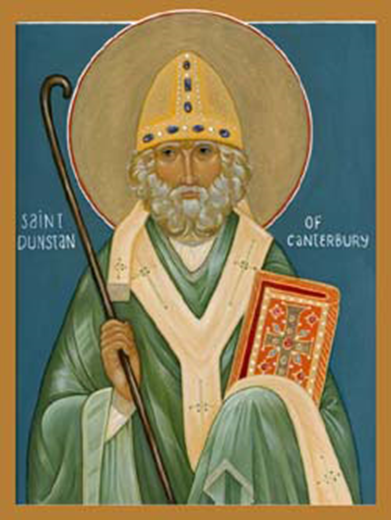Catholic Life
Who was Saint Dunstan?

He was born and lived in the 10th century in what has become known as Anglo-Saxon England – before the time of William the Conqueror. It was a period of time when England was constantly under threat by the Vikings, who already held large parts of Northern Britain.
The exact date of Dunstan’s birth is not certain. However, the importance of his life and its influence on history is far greater than the pin-pointing of his birth date. The generally accepted birthday date is generally accepted as being in a year roughly 600 years after the Romans left Britain and about 1150 years before William the Conqueror came to England from Normandy.
Dunstan lived with his father Heorstan, his mother Cynethryth and his brother Wulfric in a house on the marshes at Glastonbury, in what is now Somerset. As a little boy he would go with them along through the marsh to the church below the Tor which was built by Saint Patrick.
Dunstan was a distant relation of King Athelstan, who was currently on the throne and at some time in his teens, he was sent to live at the court for a while. We are told that he was a very bright boy, good at music and mathematics and a lively talker. He was fond of painting and liked to draw buildings and to make things out of metal.
In 940 following the death of King Aethelstan he was summoned by the new king, Eadmund and appointed a counsellor, but he was driven from the court by jealous courtiers. After narrowly escaping death while hunting, the King remembered the harsh treatment that St Dunstan had received at court. At Glastonbury he took St Dunstan by the hand, gave him a kiss of peace and led him to the abbot’s throne.
In his position as Abbot of Glastonbury, St Dunstan set about recreating the monastic life and rebuilding the abbey. He rebuilt the church of St Peter, the cloister and re-established the monastic enclosure. Only two years later King Eadmond was assassinated, and was succeeded by Eadred. As Abbot of Glastonbury, Dunstan was appointed guardian of the royal treasure. The new king encouraged the spread of regular Christian observance and the expulsion of heathendom. Dunstan became deeply involved in secular politics and incurred the enmity of the West Saxon nobles for denouncing their immorality and for urging peace with the Danes.
In 955 Eadred died and was succeeded by Eadwig. After the coronation, Dunstan was again forced to flee from the court. This time he took refuge at a Benedictine monastery in Ghent. He stayed in Ghent for a year during which time he came into contact with the reformed continental monasticism which was to inspire his vision of Benedictine perfection.
In 957, the nobles, unable to endure the excesses of Eadwig, drove him out. His successor Eadgar asked St Dunstan to return and appointed him Archbishop of Winchester. He received the pallium from Pope John XII in Rome in 960.
With his power as Archbishop, he pushed forward reforms of Church and State to maintain order and respect for the law, and rebuilt many of the monasteries destroyed by the Danish invaders. Priests were required to live chastely, teach their parishioners the Catholic faith and handicrafts. The kingdom prospered under a peace that few had experienced before.
Dunstan crowned Edgar king with great ceremony at Bath. It is this form of coronation which has been handed down in England to this day.
King Eadgar died in 975 and was succeeded by his eldest son Eadward. His stepmother disputed the succession preferring her son Æthelred to take the throne ,and civil war almost sprung up in the kingdom. King Eadward was assasinated at Corfe Castle and his step brother Æthelred the Unready became king. Dunstan gave him a solemn warning at his coronation of the misfortunes which would befall his reign.
Saint Dunstan’s influence under the new monarch began to wane and he retired to Canterbury to teach at the cathedral school. For the last part of his life, Dunstan was busy improving the schooling of English children so that in the care of good monks many might learn to read and write. This helped to raise the standard of living for many people.
As an old man, Dunstan still rode up and down the whole country, visiting churches and monasteries, putting things right where needed. He did a great deal of rebuilding at what is now Canterbury Cathedral.
He died on Sunday 19 May 988 three days after the Ascension Day Vigil, having received the Sacraments for the last time and died peacefully. He was buried in Canterbury Cathedral.
Reference: Taken from writings by Pat Burling, published by St Dunstan’s Church, King’s Heath 1988.


